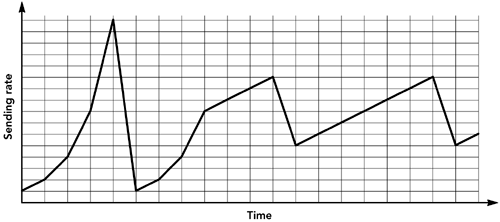Effects of Transport Protocols
| Thus far, our consideration of network characteristics has focused on IP. Of course, programmers almost never use the raw IP service. Instead, they build their applications on top of one of the higher-layer transport protocols, typically either UDP or TCP. These protocols provide additional features beyond those provided by IP. How do these added features affect the behavior of the network as seen by the application? UDP/IPThe User Datagram Protocol (UDP) provides a minimal set of extensions to IP. The UDP header is shown in Figure 2.14. It comprises 64 bits of additional header representing source and destination port identifiers, a length field, and a checksum. Figure 2.14. Format of a UDP Header The source and destination ports identify the endpoints within the communicating hosts , allowing for multiplexing of different services onto different ports. Some services run on well-known ports; others use a port that is dynamically negotiated during call setup. The length field is redundant with that in the IP header. The checksum is used to detect corruption of the payload and is optional (it is set to zero for applications that have no use for a checksum). Apart from the addition of ports and a checksum, UDP provides the raw IP service. It does not provide any enhanced reliability to the transport (although the checksum does allow for detection of payload errors that IP does not detect), nor does it affect the timing of packet delivery. An application using UDP provides data packets to the transport layer, which delivers them to a port on the destination machine (or to a group of machines if multicast is used). Those packets may be lost, delayed, or misordered in transit, exactly as observed for the raw IP service. TCP/IPThe most common transport protocol on the Internet is TCP. Although UDP provides only a small set of additions to the IP service, TCP adds a significant amount of additional functionality: It abstracts the unreliable packet delivery service of IP to provide reliable, sequential delivery of a byte stream between ports on the source and a single destination host. An application using TCP provides a stream of data to the transport layer, which fragments it for transmission in appropriately sized packets, and at a rate suitable for the network. Packets are acknowledged by the receiver, and those that are lost in transit are retransmitted by the source. When data arrives, it is buffered at the receiver so that it can be delivered in order. This process is transparent to the application, which simply sees a "pipe" of data flowing across the network. As long as the application provides sufficient data, the TCP transport layer will increase its sending rate until the network exhibits packet loss. Packet loss is treated as a signal that the bandwidth of the bottleneck link has been exceeded and the connection should reduce its sending rate to match. Accordingly, TCP reduces its sending rate when loss occurs. This process continues, with TCP continually probing the sustainable transmission rate across the network; the result is a sending rate such as that illustrated in Figure 2.15. Figure 2.15. Sample TCP Sending Rate This combination of retransmission, buffering, and probing of available bandwidth has several effects:
Of course, there are subtleties to the behavior of TCP, and much has been written on this subject. There are also some features that this discussion has not touched upon, such as push mode and urgent delivery, but these do not affect the basic behavior. What is important for our purpose is to note the fundamental difference between TCP and UDP: the trade-off between reliability (TCP) and timeliness (UDP). |
EAN: 2147483647
Pages: 108

